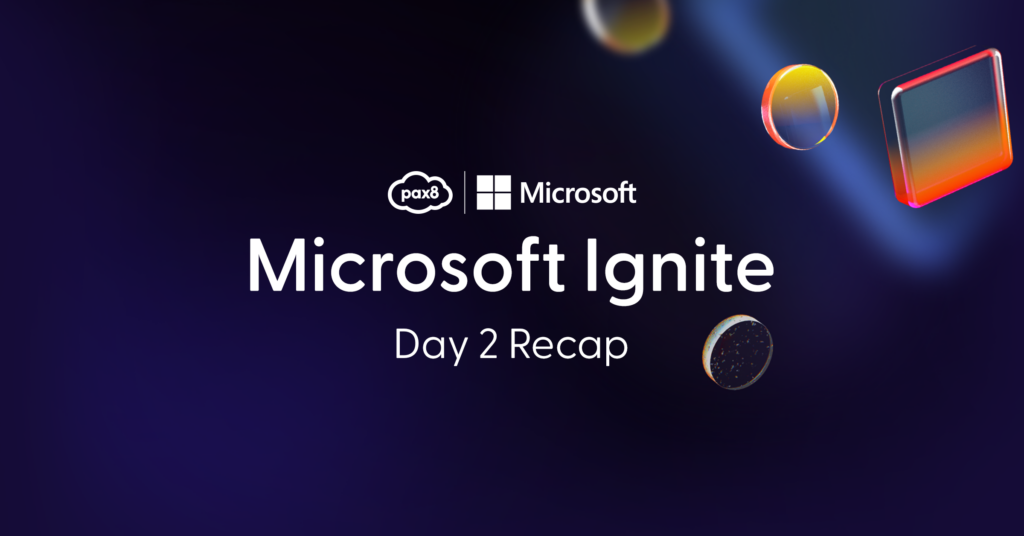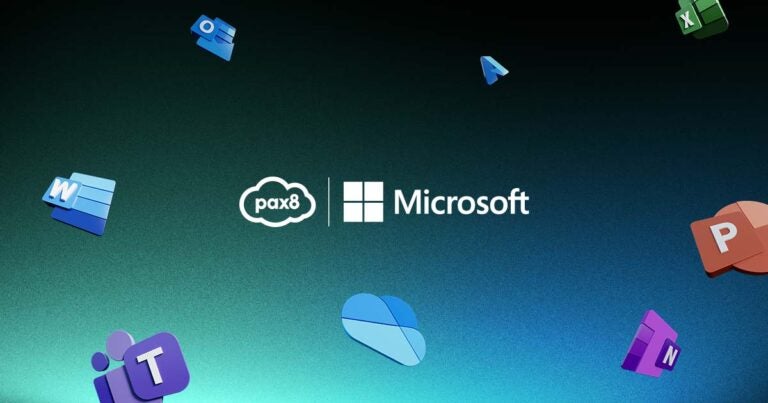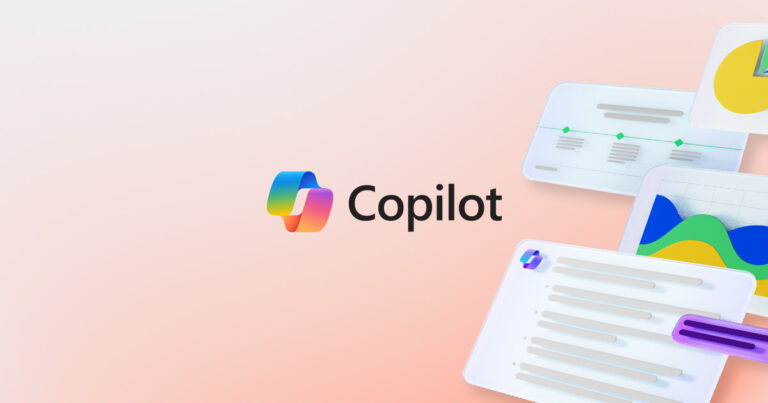What you need to know from Day 2.
It’s Day 2 of Microsoft Ignite and the Pax8 Microsoft team has been working diligently behind the scenes to cover the key highlights from today’s digital event. Day 2 was filled with deeper technical details and product demos of the announcements made on Day 1. If you missed any of the action, don’t worry, Microsoft has you covered with their Ignite Recap. Here you can watch the keynote sessions on demand and have direct access to resources such as the Official Microsoft Blog & Book of News to review any of the coverage you may have missed.
Below are some of our top takeaways from Day 2, including Microsoft announcements, product news, and best practice guidance.
Microsoft Ignite into Focus: Business Applications Session
As we saw yesterday, Microsoft is using data as the fabric for every process and interaction employees are having. The solutions Microsoft is building are focused on solving problems through process and helping businesses go from being reactive to predictive with deliberate communication. In this session, we saw Microsoft showcase and demo how businesses are succeeding with the following Dynamics 365 and the Power Platform solutions:
Dynamics 365 Sales: We saw Microsoft delve into how Sandvik Cormant is transforming the way their sales teams interact with clients. From intelligent lead routing to integrating Teams into Dynamics 365 Sales, Microsoft is using data to empower sellers to intelligently engage with their clients.
Dynamics 365 Customer Service: Much like with their sales team, Sandvik Cormant modernized the way their support staff engage with clients for a wholistic sales cycle. With Dynamics 365 Customer Service, support agents are intelligently suggested cases based on their expertise and workload but will also suggest other support agents to connect with based on previous case experience to accelerate the way current cases are solved.
Dynamics 365 Customer Insights: W.B. Mason is using Dynamics 365 Customer Insights to help manage their current book of business more efficiently. With data powered engagement insights, W.B. Mason can investigate the health of their clients and get suggested actions on how to engage with the client to build better relationships and prevent churn.
Dynamics 365 Marketing: Alongside Dynamics 365 Customer Insights, W.B. Mason is also using Dynamics 365 Marketing for their customer outreach. With AI-suggested content ideas, employees are now able to easily create official, hyper-personalized W.B. Mason outreach content for the recipient.
Dynamics 365 Guides: At the heart of the Toyota philosophy is kaizen, continuous improvement. Here we saw Toyota use Dynamics 365 Guides and HoloLens to improve their manufacturing process. Users are now able to create and manage knowledge guides digitally with AI Builder Guide and can follow step by step the processes in a mesh experience with little previous experience.
Power Apps: Xerox is using the Modern App Designer combined with Dataverse and the low code app building experience in Power Apps to create converged apps with powerful features. Intelligent authoring in Power Apps makes it easy for anyone to start building and testing an app for any end user experience whether it is PC or mobile.
Power Automate: Combined with Power Apps, Xerox is using Power Automate to document automation solutions with AI Builder capabilities. AI-suggested flows paired with seamless collaboration in app makes it easier than ever for organizations to build automation.
Accelerate Your Cloud Migration and Modernization Journey with Azure Session
The past two years have seen unprecedented changes. In 2020, organizations began responding in real time with solutions to maintain business continuity to power remote work & learning options and to ensure the well-being and safety of both employees & customers. Throughout 2021, and moving forward into 2022, businesses have begun recovering and reimagining the future.
Microsoft has seen no slowing down when it comes to cloud adoption, as organizations seek a trusted cloud to better enable effective hybrid work and revitalize stalled business strategies — one that can provide sustained innovation to meet the consistently changing behavior of their clients. Businesses are experiencing modernization triggers such as remote work, cost-optimization, cybersecurity, budget and resource constraints, and more that are driving them to find a better solution.
Azure continues to be Microsoft’s key platform as more and more organizations adopt cloud solutions. In this session, Microsoft highlighted why Azure continues to be the platform of choice for businesses. Azure provides enterprise-grade infrastructure for less while enabling organizations to innovate faster. With the need for a secure hybrid cloud being more important than ever, Microsoft keeps security at the heart of Azure and allows organizations to protect their assets with built-in compliance backed by Microsoft Defender and AI.
Microsoft also provides migration and adoption resources with their Azure Migration & Modernization Program — be sure to take a look at azure.com/ammp.
Accelerate Nonprofit Impact with Microsoft Cloud for Nonprofit Session
The work nonprofits perform around the world is needed now more than ever to help the most vulnerable populations. In their research, Microsoft found that 95% of funding decision makers say they would contribute to nonprofits if they showed how they are utilizing technology to improve on their mission deliverables. Microsoft’s Cloud for Nonprofit brings together trusted and intelligent cloud capabilities as well as industry-specific solutions to accelerate nonprofit mission impact.
Microsoft Cloud for Nonprofit is built upon Microsoft’s mature architecture and leverages years of investment. The personalized donor & constituent management powers are present across their suite of applications: Dynamics 365, Power Platform, Microsoft Teams, Azure, and LinkedIn. Microsoft Cloud for Nonprofit allows nonprofit organizations to better know their donors & supporters all while accelerating their mission outcomes and delivering effective programming — this is all powered by:
– Fundraising and Engagement: Organizations can easily manage existing and new constituents and opportunities using Fundraising and Engagement powered by Dynamics 365.
– Volunteer Management: Nonprofits will be able to manage their volunteer information, all while scheduling, communicating, and accessing attendance and engagement data.
– Constituent Marketing Journey: Pre-built campaigns and market segments make it easier than ever for nonprofit organizations to manage customer journeys in real time.
– Volunteer Engagement: Nonprofit organizations can search for engagement opportunities and review summaries of current engagement to better understand their volunteers and their overall impact to mission outcomes.
To learn more about Microsoft Cloud for Nonprofit and how Microsoft is supporting nonprofits, visit their Nonprofit Solution landing page.
Microsoft Ignite into Focus: Data & Azure AI Session
In this session, we saw Microsoft make key announcements around their data & AI solutions. Microsoft shared that SQL Server 2022 is coming alongside their OpenAI Service and Analytics, a new processing engine. Additionally, we heard that Synapse Link will be entering general availability.
Integrating AI within Azure continues to be key in this session. Azure AI provides a machine learning platform where organizations can customize their AI models with cognitive services and provide scenario-based services through applied AI. Applied AI Services was announced and will be providing a new studio experience. It will be available in over 120 languages and 50 additional languages for semantic search.
Accelerate Innovation with Low-Code Application Using Power Platform Session
With a focus on data driven insights comes tools to be able to power those insights – this is where Microsoft’s Power Platform comes in. Power Platform provides organizations with:
– Power BI is a low code way to visualize, explore, and analyze data.
– Power Apps provides a low code approach to building web and mobile applications.
– Power Automate enables the development of low code workflow automation.
– Power Virtual Agents allows organizations to build chat bots and conversational elements.
In addition to Power Platform, this session also introduced Fusion Teams. Fusion Teams will help:
– IT Professionals build and deliver apps and provide ongoing governance.
– Business Analysts identify teams and requirements and pull in key leads.
– Professional Developers start building a service that interacts with legacy data and APIs.
– Citizen Developer build UX and collaborate within the same app.
As Microsoft helps organizations scale through Fusion Teams, they will also be previewing Power Apps Pay-as-You-Go on Azure and Power Apps mobile apps on iOS and Android.
The Future of Business is Seamless Collaboration Session
Continuing with the theme from Day 1, we saw a strong focus on the updates in Microsoft Teams and how it is becoming the center of communication and collaboration for organizations. The future of the modern workplace is collaborative, and it is important for businesses to understand how their teams work together and interact within the broader organization. Collaborative apps enable easy development and deployment, which is why combining Teams with Power Platform is essential.
Microsoft announced that its embedding Power Apps into Teams to automate interaction within channels and embedding actionable insights via Power BI as a systems dashboard. Additionally, Microsoft is making it easier for developers by enabling search across Dataverse data from Microsoft 365 and integrating collaboration with Teams directly in the new Modern App Building Experience.
Microsoft Ignite into Focus: Data Application & Innovation Session
In this session, Microsoft showcased their focus on providing products that accelerate an organization’s impact. Organizations can easily manage their databases and DevSecOps with low code app development solutions like Power Apps and Virtual Machines (VMs). Microsoft is empowering developers to innovate by building cloud-native apps and modernizing existing applications.
Tools such as Visual Studio Code, GitHub Actions, and Playwright all focus on helping developers edit, automate, and test great apps. With this in mind, GitHub’s engineering team has moved to Codespaces. This transition allows for automated cost control and provisioning of developer environments in less than 15 seconds powered with up to 32 cores + 64GB RAM.
Other Top Takeaways
Here are additional takeaways from other sessions that happened today.
Cloud-native apps are reliable, agile, secure, and scalable. By 2025, more than 90% of new apps will be cloud-native. No service is more central to cloud-native practices than Azure Kubernetes. Azure Containers and Kubernetes increases application portability and promotes a wide variety of application architectures that meet organizational needs.
Organizations need to be digitally empathetic and provide resilient security. With the shift to hybrid work during the pandemic, Microsoft has seen an over 200% increase in cyber threats. For organizations looking to better their security posture, Windows Hello and MFA need to be implemented. Microsoft found that strong authentication can prevent 99.9% of identity attacks.
Additional quality of life features for Microsoft Teams. As we see Microsoft double down on the importance of Teams, they are also introducing qualify of life features for the platform. Native Bluetooth connectivity and hold music for VoIP calls & transfer situations were announced today, along with the ability to control the hand raise feature using the Teams button on call control devices. Admins will also be able to control video call settings for users based on their bandwidth and can disable video when in a low bandwidth area and reenable once in a high bandwidth area.
Microsoft ❤️’s Java. Microsoft announced Azure Spring Cloud Enterprise and Java EE Support on Azure container platform. With this, Oracle WebLogic Server will be on Azure Kubernetes Service and IBM WebSphere Liberty will be on Azure Kubernetes Service and Azure Red Hat OpenShift.
All Your Ignite Questions, Answered.
Microsoft Ignite has wrapped up, and we’re fired up for all the new things coming to Microsoft. If you have any questions about the content covered in Ignite, schedule a call with your Pax8 rep and one of our brilliant Microsoft experts.




